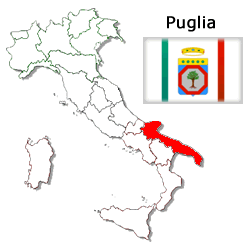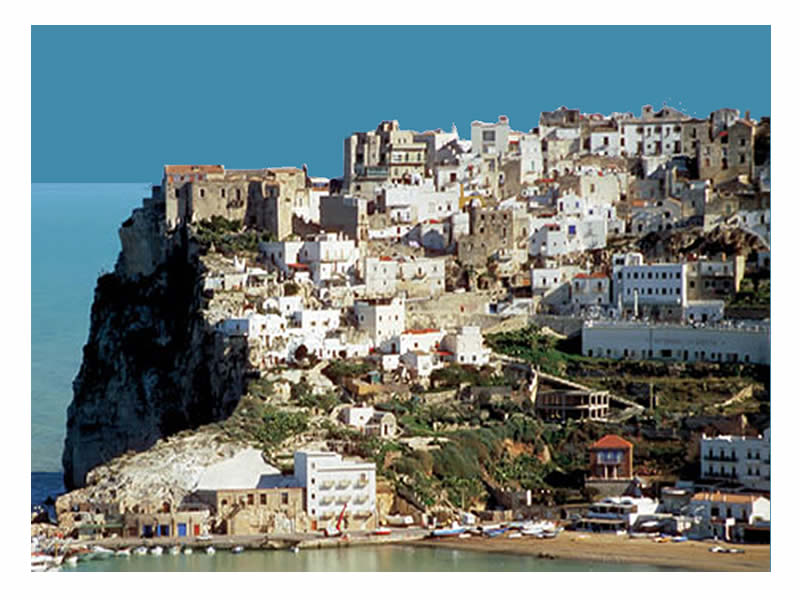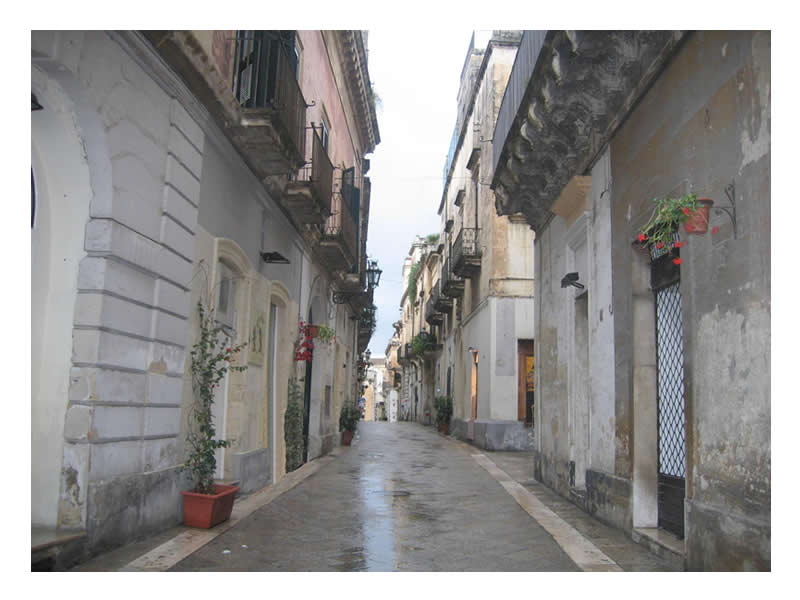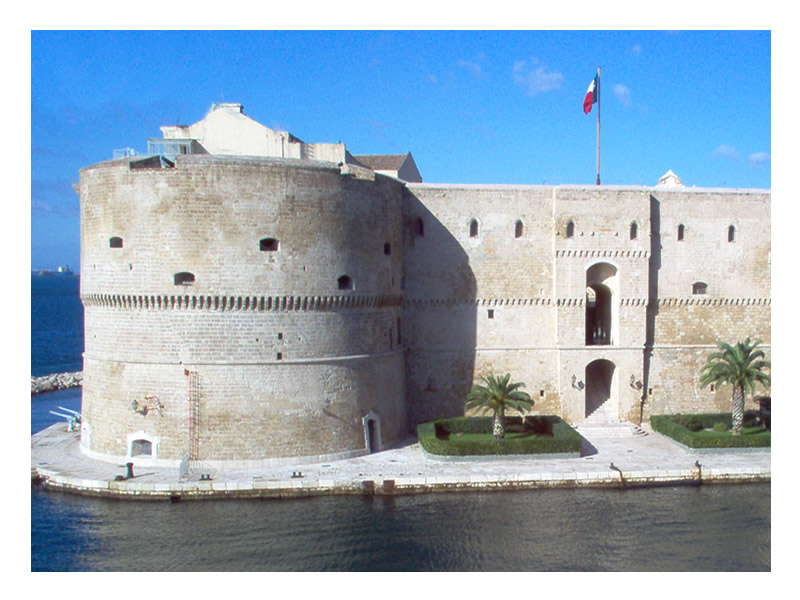|
 Information on Puglia - Italy Information on Puglia - Italy
 Bari Bari  Brindisi Brindisi  Foggia Foggia  Lecce Lecce  Taranto Taranto
Puglia is adorned with a long, beautiful coast line, largely free of tourists and development. The heel and spur of Italy's boot produces hearty fruits and vegetables, a main addition of Puglian cuisine.
Puglia's cuisine is fairly uniform, due to the friendly attitude in this flat country side. Relying on the same ingredients through out the region.
Tomatoes, fennel, peppers, lettuces, wild chicory and onions grow well there and are eaten raw at the beginning of a meal or served at the end of a meal with fruit. Between courses, pasta takes center stage. The types and shapes of pasta, made from Italy's best durum wheat, are more numerous here than in any other area of Italy. The most popular cuts are maccheroni, spaghetti, cavatelli, tiny gnocchi, and the region's most famous creation, orecchiette ("little ears"). Pasta sauces typically contain cauliflower, eggplant, chickpeas, fava beans, and broccoli florets.
Sheep's milk cheese is another important component of Puglian cuisine, as is the bounty of excellent seafood (particularly oysters, mussels and clams pulled from the Adriatic Sea.
Puglia is also reputed for its fabulous deep green olive oil, which competes with Tuscany and Liguria in quality. But grapes are probably the region's most important crop, as Puglia produces more grapes, both for eating and wine-making, than any other region in Italy.
 We welcome inquiries for available accommodations for the region of Puglia and surrounding areas. Contact us for listing requirements. (Hotels - Motels - Villas - Bed & Breakfast - Condo Rentals, Agriturismo & all related accommodations) We welcome inquiries for available accommodations for the region of Puglia and surrounding areas. Contact us for listing requirements. (Hotels - Motels - Villas - Bed & Breakfast - Condo Rentals, Agriturismo & all related accommodations)
|
| |
|
| |
|
| |
Foggia
 The Province of Foggia is administratively divided into 64 Municipalities. The Parco nazionale del Gargano, established in 1995, is a peninsula partly mountainous and partly covered by the remains of an ancient forest, Foresta Umbra, the only remaining part in Italy of the ancient oak and beech forest that once covered much of Central Europe, and in the north are two major salty lakes, Lesina and Varano; the coastline is a sequel of greatly spectacular bays and cliffs, a paradise for summer tourism. The Province of Foggia is administratively divided into 64 Municipalities. The Parco nazionale del Gargano, established in 1995, is a peninsula partly mountainous and partly covered by the remains of an ancient forest, Foresta Umbra, the only remaining part in Italy of the ancient oak and beech forest that once covered much of Central Europe, and in the north are two major salty lakes, Lesina and Varano; the coastline is a sequel of greatly spectacular bays and cliffs, a paradise for summer tourism.
Monte Gargano is also the site of the oldest shrine in Western Europe dedicated to the archangel Michael, Monte Sant'Angelo sul Gargano. Another area of great beauty is the picturesque Tremiti island group.
The province includes vast territories of intensive agriculture, in previous centuries largely used as pastures for the flocks coming in the winter months from Abruzzi, Molise, Irpinia and Lucania.
Today is also a place of pilgrimage due to the presence of the sanctuary of San Pio da Pietrelcina (Padre Pio) in San Giovanni Rotondo.
 What to taste: What to taste:
• Although bread is popular everywhere in Italy it seems to be predominant in Apulian cuisine. Mainly the tasty bruschetta or a slice of stale bread topped with tomatoes and raw onions and drizzled with the excellent local olive oil. There is also the pizza and focaccia smothered with juicy tomatoes, sweet onions and fresh anchovies.
• Lamb meat, tender and delicate, is used as an extra for pasta dishes or to prepare typical main courses.
• The soups that are popular are maritata and minestrone.
• The sea with its fish soups, grills and recipes with blue fish. An excellent lobster sauce is used as condiment for pasta dishes and, for those who love "raw" food, the intense flavour of oysters of Gargano.
• There is the production of cheeses that includes, among the typical products, the canestrato, ripened into "fiscelle" (wicker baskets); pecorino (sheep milk cheese), great to eat with a slice of Pugliese bread or to season pasta dishes; and Mattinata cheeses, from a small peasant village surrounded by unspoiled nature, where the dairy production respects ancient traditions.
• The local wine includes San Severo, Orta Nova and Daunia.
 Cities & Towns: Cities & Towns:
 Coming soon Coming soon
 What to do: What to do:
• The wonderfull sea and the richness of the seabed of the Gargano and Tremiti Islands offer the opportunity to practice all forms of water sports. Sailing, windsurfing, kite surfing and canoeing to explore every corner of this earthly paradise, and diving for those who, expert or amateur, like plunging into the deep blue of the sea and swim among the lush and colourful vegetation of the seabed and the different species of fish that populate, undisturbed, the marine reserve of the Tremiti Islands.
• The Park of Gargano is a paradise for those who love bird-watching, both in winter and summer. Stilts, avocets, little terns, rosy gulls, ferruginous, night herons, egrets are just some of the many species that can be spotted walking in the green land of this natural jewel.
 Places to visit: Churches, Museums, Ruins, Piazzas, Fountains, Places to visit: Churches, Museums, Ruins, Piazzas, Fountains,
• The Islands of Gargano and Tremiti are the beauty the province of Foggia.
Clean and clear waters, caves, inlets, colourful gardens and lush vegetation are the distinguishing features of these masterpieces of nature. Among the many places to visit, Vieste is certainly the most famous. Long stretches of sand with a characteristic colour, lapped by a beautiful sea, alternate with stretches of coastline interrupted by numerous marine cavities such as the Sfondata and the Grotta Smeralda (Emerald Cave).
• The white small houses, the intense green of the Mediterranean bush and the blue of the sea are the colours that tinge the pretty Peschici, with beaches nestled in the rocky walls of the coast, ideal places to relax under the sun while being refreshed by a gentle sea breeze.
• Futher into the plain of the Tavoliere there is Lucera, an ancient village built on a Neolithic settlement and the scene of important historical events. Lucera experienced a great cultural and urban development during the Roman period when the great Amphitheater was built. Two great doorways, adorned with Ionic columns mark the entrance to the arena, crossed by a tunnel and three underground rooms used for housing animals and the tools used during games and public spectacles.
Testimony to the Swabian-Angevin period is the fortress that dominates the whole town. Built by Frederick II where the ancient Roman acropolis was, it was later enhanced by Charles I of Anjou with the construction of a 900 metre wall, with 22 watchtowers and a deep moat dug around the perimeter.
Overlooking the beautiful Piazza Duomo is the Angevin Cathedral dedicated to Santa Maria dell'Assunta, patron saint of the town. The external façade has an asymmetrical structure and three access portals. The interior, divided into three naves, contains interesting works of art.
 Events: Events:
•
There is the famous Carnevale Dauno di Manfredonia (Dauno Carnival of Manfredonia), now in its 57th edition, a great colourful party with a rich parade of floats and masked groups of participants.
 Tours avaiable in the region: Tours avaiable in the region:
 Accomodations in close proximity: Hotels, Restorts, Holiday Houses, Condo Rentals, Farm Holidays (Agritourismo), Accomodations in close proximity: Hotels, Restorts, Holiday Houses, Condo Rentals, Farm Holidays (Agritourismo),
 Flights - Car Rentals - Cruises: Flights - Car Rentals - Cruises:
 Restaurants in close proximity: Restaurants in close proximity:
• (Add a restaurant review in the italian blog area of our website).
|
|
| |
Lecce
 Situated at the south-estern edge of Italy, the province occupies the area called Penisola Salentina with the Adriatic Sea to the east and the Ionian to the south and west, a unique landscape of rugged, reddish territory, villages of white-painted houses, all between sea and sky of astounding blue, and including the two splendid lakes of Alimini Grande and Alimini Piccolo. Here and there magnificent churches and palaces, witnesses of the historical heritage of crossroads of cultures, thanks to the strategical position on the channel of Otranto. Situated at the south-estern edge of Italy, the province occupies the area called Penisola Salentina with the Adriatic Sea to the east and the Ionian to the south and west, a unique landscape of rugged, reddish territory, villages of white-painted houses, all between sea and sky of astounding blue, and including the two splendid lakes of Alimini Grande and Alimini Piccolo. Here and there magnificent churches and palaces, witnesses of the historical heritage of crossroads of cultures, thanks to the strategical position on the channel of Otranto.
Also the local cuisine shows traits of the Arab, Spanish and Greek dishes, and the local dialect has many similarities with ancient Greek. The ancient name of the province was Terra d’Otranto, with capital Lecce, including also the territory of the present province of Taranto.
 What to taste: What to taste:
• Simplicity is the formula in this region where vegetables, oil, bread and pasta are the basic ingredients. Pasta types that include orecchiette, maccheroncini and tagliatelle covered with simple fresh tomato sauce flavoured with basil and pecorino or cacio ricotta cheese.
• Most of the local cusine incorporates all the local agricultural ingredients and fresh local fish. Urchins, mussels and oysters eaten "raw" are for those who love the strong taste of the sea.
• The local desserts include pasticciotto filled with custard cream, Lecce cotognata, dried figs and taralli. Also try the mostaccioli, coated with chocolate and made with grape juice and jam.
• The local wines include Aleatico, Squinzano, Cupertino, Galatina, Leverano Matino, Nardo and Salento.
 Cities & Towns: Cities & Towns:
 Coming soon Coming soon
 What to do: What to do:
• Surrounded by the sea it is a true nature lovers paradise with all varieties of water sports.
• Scuba diving enthusiasts will be delighted by the underwater landscape, with its extensive colourful seagrass meadows of gorgonians and poseidonia, and rich in canals, cavities and crevices to explore.
Santa Cesarea Terme,
• In addition to being one of the best places to practice diving, is an important spa, known for the curative properties of the sulphur water gushing from the four caves.
 Places to visit: Churches, Museums, Ruins, Piazzas, Fountains, Places to visit: Churches, Museums, Ruins, Piazzas, Fountains,
• Piazza Duomo, once used as a fortress and today considered the most elegant "salon" in the city. The grandeur of the Duomo, work of Zimbalo, Cino and Penna, the five-storey tall bell tower, the Palazzo Vescovile (Bishop's Palace) and the Palazzo del Seminario (Seminary) mark the perimeter of the square, one of the monumental works that best represents the magnificence of Lecce's style.
Not far away, Piazza Sant'Oronzo includes in its perimeter the city's history.
• Symbol of the Renaissance is the Palazzo del Seggio, known as the "Seat", which today hosts important art exhibitions, and the Chiesa di Santa Maria delle Grazie (Church of Saint Mary of the Graces), with its interesting frescoes and wooden works.
• The Porta Rudiae, crowned with statues of Saint Orontius, Saint Irene and Saint Dominic, with two pairs of columns located on either side of the central arch, behind which stands the Chiesa del Rosario (Church of the Rosary) that strikes the eye with the artistic imagination of its the grand façade.
• Imposing and majestic isNot to be missed is a visit to the Basilica di Santa Croce (Basilica of the Holy Cross), where the inspiration of the master "masons" is visible in every part of the monumental façade that anticipates the beauty of the interior, a harmonious balance between the sobriety of the classical style and the splendour of Lecce baroque.
• Between Otranto and Gallipoli, the strength of winds and sea has carved the limestone cliffs, giving rise to evocative natural caves like Grotta Zinzulusa, full of stalactites and stalagmites, the Grotta Grande del Ciolo and the caves of the Natural Park of Porto Selvaggio.
 Events: Events:
•
Sacred or secular, every year many festivals and celebrations take place in every corner of Salento: opportunities to enjoy fun and folklore and the traditional local cuisine.
• Those who want to bring back home some souvenirs can purchase handicrafts from Salento, made with papier mâché, the raw material for dolls and Christmas crib figures; terracotta clay, used for making pots and various traditional fancy goods; wrought iron, mainly used to produce utensils and fireplace tools; Lecce stone, inlaid by the skilful stone cutters with flair and imagination.
 Tours avaiable in the region: Tours avaiable in the region:
 Accomodations in close proximity: Hotels, Restorts, Holiday Houses, Condo Rentals, Farm Holidays (Agritourismo), Accomodations in close proximity: Hotels, Restorts, Holiday Houses, Condo Rentals, Farm Holidays (Agritourismo),
 Flights - Car Rentals - Cruises: Flights - Car Rentals - Cruises:
 Restaurants in close proximity: Restaurants in close proximity:
• (Add a restaurant review in the italian blog area of our website).
|
|
| |
Taranto
 Taranto is a coastal city in Apulia, the capital of the province of the same name and an important military and commercial port. It has well-developed steel and iron foundries, oil refineries, chemical works, some shipyards for building warships, and food-processing factories. Taranto is a coastal city in Apulia, the capital of the province of the same name and an important military and commercial port. It has well-developed steel and iron foundries, oil refineries, chemical works, some shipyards for building warships, and food-processing factories.
Taranto history dates back to the 8th century BC when it was founded as a Greek colony. The ancient city was situated on a peninsula, protected by a helm; the modern city has been built over the ancient Greek necropolis.
The islets S. Pietro and S. Paolo protect the bay (called Mar Grande, Big sea) where the commercial port is located. Another bay, called Mar Piccolo (Small sea), is formed by the old city, and there fishing is flourishing; Mar Piccolo is a military port with a strategic importance; at the end of the XIX century, a channel was excavated to allow the military ships to enter Mar Piccolo harbour, and the ancient Greek city become an island. In addition, the islets and the coast are strongly fortified. Because of the presence of these two bays, Taranto is also called "the city of the two seas".
 What to taste: What to taste:
• Mussels and oysters, the pride of Taranto, but also fish and shellfish, can be tasted combined with typical Apulian pasta.
• There is also the local extra virgin oil. There is also the local coldcut meat with names like capocollo of Martina Franca.
• Fruits also figure predominantly with a wide variety of very sweet fruit: grapes, oranges, and the famous clementines of the Gulf of Taranto.
• The local wine includes Primitivo di Manduria, the Martina Franca and the Lizzano
 Cities & Towns: Cities & Towns:
 Coming soon Coming soon
 What to do: What to do:
• In the Taranto province there are many routes to discover the finest wines and olive oils with a quality appellation or the art of ceramics that has made this land famous.
• The many landscapes in this area of Apulia offer the possibility of organizing very interesting excursions. An interesting destination for lovers of photography and bird watching is the Lake of Salinella near Marina Ginosa, where pine forests, clearings and sandy areas are home to a rich variety of wildlife and birds.
• There are also a variety of water sports in the area.
 Places to visit: Churches, Museums, Ruins, Piazzas, Fountains, Places to visit: Churches, Museums, Ruins, Piazzas, Fountains,
• Taranto is called, "The City of Two Seas" and is located on a spit of land that separates the open sea known as mar Grande, from the mar Piccolo. The artificial channel that connects them is surmounted by the famous swing bridge, beyond which lies the heart of the old Taranto, an ancient medieval town with the Cathedral of San Cataldo, the Aragonese Castle, also known as Castel Sant'Angelo, and many other monuments that tell the story of its ancient origins.
• Along the coast there are many lovely places to enjoy a holiday of relaxation and fun diving into the crystal clear waters of the Ionian and enjoying the sun lying on the fine white sand of the long coastlines.
•
To the north of Taranto, Marina di Vinosa, a small jewel of nature where the transparent water of the sea reflects the blue of the sky and the green of the pine forests. Near the Salento is located Marina di Pulsano, where low cliffs, white inlets and clear waters offer visitors a truly beautiful landscape.
• To the south of the province capital, another charming area, Marina di Leporano, is perfect for those who prefer a jagged coastline with cliffs interrupted by small sandy beaches. The sea, though beautiful, is not the only attraction of this land.
• An extraordinary landscape makes up the beautiful hinterland of Taranto: sometimes green and lush with large vineyards and olive groves, sometimes rocky and rough with ravines, caves and gorges where ancient civilizations had their settlements.
• There is also the presence of prehistoric ruins, including the Villaggio di Triglie. Castellaneta lies in the heart of the Parco delle Gravine, a mix of natural environments even more evocative due to the remains of an ancient history.
North of Taranto, Martina Franca is a charming town overlooking the Itria Valley, with a lush green nature broken by the white trulli and ancient farms that frame the baroque architecture of the old town.
 Events: Events:
• Coming soon.
 Tours avaiable in the region: Tours avaiable in the region:
 Accomodations in close proximity: Hotels, Restorts, Holiday Houses, Condo Rentals, Farm Holidays (Agritourismo), Accomodations in close proximity: Hotels, Restorts, Holiday Houses, Condo Rentals, Farm Holidays (Agritourismo),
 Flights - Car Rentals - Cruises: Flights - Car Rentals - Cruises:
 Restaurants in close proximity: Restaurants in close proximity:
• (Add a restaurant review in the italian blog area of our website).
|
Home | Advertising Information | Contact Us
Copyright ©2002 Italian Recipes Trinakria Development. All rights
reserved. |
 |
|
 |


 Information on Puglia - Italy
Information on Puglia - Italy The Province of Foggia is administratively divided into 64 Municipalities. The Parco nazionale del Gargano, established in 1995, is a peninsula partly mountainous and partly covered by the remains of an ancient forest, Foresta Umbra, the only remaining part in Italy of the ancient oak and beech forest that once covered much of Central Europe, and in the north are two major salty lakes, Lesina and Varano; the coastline is a sequel of greatly spectacular bays and cliffs, a paradise for summer tourism.
The Province of Foggia is administratively divided into 64 Municipalities. The Parco nazionale del Gargano, established in 1995, is a peninsula partly mountainous and partly covered by the remains of an ancient forest, Foresta Umbra, the only remaining part in Italy of the ancient oak and beech forest that once covered much of Central Europe, and in the north are two major salty lakes, Lesina and Varano; the coastline is a sequel of greatly spectacular bays and cliffs, a paradise for summer tourism.  Situated at the south-estern edge of Italy, the province occupies the area called Penisola Salentina with the Adriatic Sea to the east and the Ionian to the south and west, a unique landscape of rugged, reddish territory, villages of white-painted houses, all between sea and sky of astounding blue, and including the two splendid lakes of Alimini Grande and Alimini Piccolo. Here and there magnificent churches and palaces, witnesses of the historical heritage of crossroads of cultures, thanks to the strategical position on the channel of Otranto.
Situated at the south-estern edge of Italy, the province occupies the area called Penisola Salentina with the Adriatic Sea to the east and the Ionian to the south and west, a unique landscape of rugged, reddish territory, villages of white-painted houses, all between sea and sky of astounding blue, and including the two splendid lakes of Alimini Grande and Alimini Piccolo. Here and there magnificent churches and palaces, witnesses of the historical heritage of crossroads of cultures, thanks to the strategical position on the channel of Otranto.  Taranto is a coastal city in Apulia, the capital of the province of the same name and an important military and commercial port. It has well-developed steel and iron foundries, oil refineries, chemical works, some shipyards for building warships, and food-processing factories.
Taranto is a coastal city in Apulia, the capital of the province of the same name and an important military and commercial port. It has well-developed steel and iron foundries, oil refineries, chemical works, some shipyards for building warships, and food-processing factories.